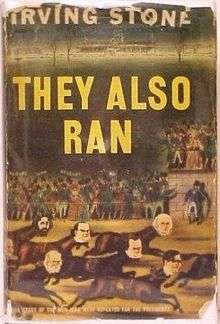They Also Ran
 First edition | |
| Author | Irving Stone |
|---|---|
| Country | United States |
| Language | English |
| Subject | U.S. political and electoral history |
| Publisher | Doubleday |
Publication date | 1943 |
| OCLC | 421063 |
| 920.073 | |
They Also Ran: The Story of the Men Who Were Defeated for the Presidency (1943) is a non-fiction book about United States presidential candidates by American writer Irving Stone, known for his popular biographical novels of artists and intellectuals. An updated edition was published in 1966, with brief analyses of the 1944 through 1964 elections.
Summary
Stone evaluates several unsuccessful candidates for President of the United States, from the elections of 1824 through 1940.[1] He explores their places in history (and those of their victorious opponents), and tries to assess whether or not the American people made the "right" choice in choosing another candidate for that office.
Structure
Stone groups the also-rans by profession. For example, the first section assesses newspapermen Horace Greeley and James M. Cox, and he happens to rate them favorably to the candidates who were elected: Grant and Harding.
Reception
The Chicago Tribune described They Also Ran as "a fascinating and challenging book,"[2]
The New York Times praised it as "a brilliant idea . . . brilliantly executed".[3]
Boyd Lee Spahr in The Pennsylvania Magazine of History and Biography criticized the book's "lack of historical continuity" in its organization, complaining that the grouping of candidates by profession did little to increase understanding. He particularly criticized it for numerous errors related to several different candidates, and said that Stone did not reflect the consensus of historians on many candidates. He said:
"Mr. Stone wields a trenchant pen but his penchant for striking sentences, and perhaps his prejudices, lead him into exaggerations and inaccuracies, with the result that some of the sketches seem like campaign propaganda, post-mortem pro or con, rather than impartial biography. In addition, factual errors are fairly numerous."[1]
Spahr concluded that while Stone was entitled to his opinions, the inaccuracies decreased the book's value as a reference.[1]
1966 edition
The book was published in an updated edition in 1966, incorporating material on elections from 1944 to 1964. It included the sections noted below:
| Book | Chapter | Subject | Comments |
|---|---|---|---|
| Book One: "The Press Pass" | I | Horace Greeley | |
| II | James Middleton Cox | ||
| Book Two: "Three Time Losers!" | I | Henry Clay | |
| II | William Jennings Bryan | ||
| Book Three: "Judge Not!" | I | Alton B. Parker | |
| II | Charles Evans Hughes | ||
| Book Four: "Generals Die in the Army" | I | Winfield Scott | |
| II | John Charles Fremont | ||
| III | George B. McClellan | ||
| IV | Winfield Scott Hancock | ||
| Book Five: "Heroes Stand Alone" | I | Samuel J. Tilden | |
| Book Six: "Main Chance Politicos" | I | Stephen A. Douglas | |
| II | James G. Blaine | ||
| Book Seven: "Governors, Pardon!" | I | Lewis Cass | |
| II | Horatio Seymour | ||
| III | Alfred E. Smith | ||
| IV | Alfred M. Landon | ||
| Book Eight: "Honest Wall Street Lawyers" | I | John W. Davis | |
| II | Wendell L. Willkie | ||
| Book Nine: "The Prosecutions Rest!" | I | Thomas E. Dewey | |
| Book Ten: "Transition" | I | Adlai E. Stevenson | |
| II | Richard M. Nixon | The 1968 U.S. presidential election had not yet occurred at the time of the writing. | |
| III | Barry M. Goldwater |
Influence
- The book inspired the Also-Ran Gallery, founded in Norton, Kansas in 1965, a collection of black-and-white portraits of unsuccessful presidential candidates that is displayed within the First State Bank building.[4]
Notes
- 1 2 3 Boyd Lee Spahr, "Review: They Also Ran by Irving Stone", The Pennsylvania Magazine of History and Biography, Vol. 69, issue 1, January 1945; pp. 82-83
- ↑ Will Davidson. "An Author Rates Presidents and Their Opponents," Chicago Tribune, 30 May 1943.
- ↑ Maxwell Gesimar, "Review: 'They Also Ran'", The New York Times, 30 May 1943
- ↑ Teresa Mendez. "Kerry joins the also-ran club", The Christian Science Monitor. 8 November 2004, accessed 7 October 2014